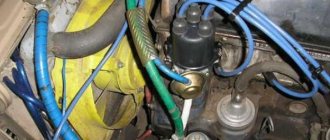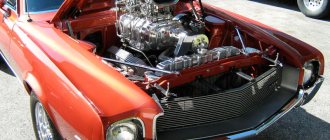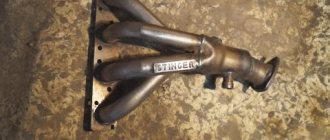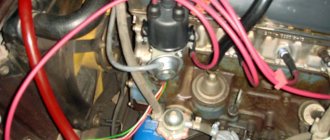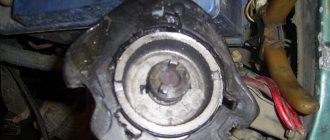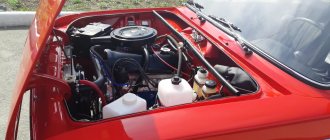- There are no reviews for this product yet.
Ignition of the fuel-air mixture in the combustion chamber of a gasoline engine is carried out using a spark that jumps between the electrodes of the spark plug. The electrical impulse required to produce a spark is created using a fairly simple device - an ignition coil. This component of the ignition system will be discussed in this article.
Source
Conversion of the distributor to the Nexia 8kl ignition module
No further changes were made to the text and diagram. Question 1 - why? Answer: - Price. 350-700 rubles per product for VAZ versus 800-2000 per product for Nexia, if the Chinese slag is Patron, AMD, Mobiletron, HUGO or about 4000 for GM - Reliability. In Nexie-like ones, the switch is shoved into a distributor, where there is a real hell inside. The distributor is screwed to the cylinder head, where the temperature is 80 and above. Electronics does not approve of heating and does ughhh. The size of the heat-conducting plate of the switch is 24*70, but whether the excess heat will be transferred to the distributor body is another question. In addition, the original switch is made like a sandwich: an aluminum plate with ceramics glued onto it, sputtered tracks on the ceramics, and sputtered resistors on the tracks. After heating cycles of all this junk, sooner or later demonic behavior begins.
VAZ switches are assembled on a regular printed circuit board, they have a lot of space, the transistor heatsink is many times larger, and the temperature is lower. — Reachability. VAZ switches are really pasture. They can be bought in the village of Verkhnie Syavki and replacement will come down to unscrewing 1 bolt and plugging the plug. Are there GM switches in the said village? Yes, if only it is a large regional center of the Verkhnesyavkinsky district. Otherwise, the transport company and Exist. For three days you can drink fresh milk and feel the tits of the local female population, laying them out in the cramped interior of Nexia in various interesting positions. — The L497B microcircuit (and its clones) in the VAZ switch is very responsible for pulling the coil. She has nothing else to do. She measures something there, counts, accumulates, charges, knows how to understand that she made a mistake and correct her mistakes in the next flash. Well, in general, she’s smart and an excellent student. She has one drawback: she can only work with Hall. And it starts at a “low” level. Rumors that VAZ switches are dying came to us from the 90s, when they were assembled by cooperatives from stolen goods from factories. It was not always possible to steal good parts. Now the circuitry has been improved. By no means, I do not encourage everyone to screw up the staff schemes. Don't touch the working mechanism. But if she started having problems and died - Wilkommen to the AvtoVAZ-handicraft-club. So, we take the switch 95.3734 (360 rubles), solder the BSZ harness from the classic (100 rubles)! and, using a soldering iron, we assemble Voltran like this hellish crap. Holy water works well as a flux.
Daewoo Nexia 1.5 - unloading the ignition switch
Daewoo Nexia 1.5 - unloading the ignition switch
Is switch offloading a myth or reality? I want to figure it out.
So, an experimental Daewoo Nexia 1.5 with a distributor, inside of which there is an inductive sensor and a switch.
Having been tired of replacing cheap switches that burned out and having read various information on the Internet, the client brought me a VAZ switch and asked me to remake the spark control system in such a way as to relieve the load on the standard circuit using an additional switch from the VAZ.
Indeed, this is discussed on many Opel and Daewoo Nexia forums and very simple connection diagrams are provided. I haven’t tried to redo it, but looking at the proposed diagrams, I see that the engine won’t even be able to start. Are the proposed modification options workable? Let's speculate.
Here is the standard diagram for Daewoo Nexia.
Ramzes4, thank you for your solidarity.
Although in many topics, for example, here on the Opel Kadett C16NZ, the author states: “I connected it according to the diagram (attached) - crap, and off we go...”. However, looking at the oscillograms in the screenshot, you can see that there is no signal at all on Pin *E* (highlighted in purple) at the moment of starter cranking. What then is his statement “shut up and let’s go”? Push the car again until the ECU sees the idle speed and sends a signal to pin *E*
I’ll finish the topic with an analysis of possible connections so that everything is in one place.
1. Connecting the reference signal (green *C*) to the VAZ switch. We get a system without ignition timing control. The respected Shamil Zagidovich described it very eloquently
Star964 wrote: The switch consists of two functional parts - a pulse shaper for the ECU, and, in fact, the switch.
For those not fully initiated, a brief description of the operation: - in the start-up mode, +5 V pulses from the driver are sent directly to the switch. That is, the ECU does not participate in the formation of the spark. These same pulses go to the ECU as reference pulses. - when the engine reaches 400 RPM, a voltage of +5 V appears at the “shunt” terminal of the ECU, which is supplied to the switching circuit in the switch. The switching circuit disconnects the driver pulses from the power transistor and connects control pulses coming from the ECU to it. Thus, after 400 RPM, the ECU begins to control the SPD.
I’ll say right away that I’m an absolute beginner in the topic of diagnostics. I need your help. Half a year ago I bought a car from the topic, the mileage was 84,000, now it’s 91,000. From the very beginning there was a problem - it stalls at idle. I went to the service center, they changed 5 pieces of IAC, they charged me 6 thousand rubles. and released, but the problem did not go away. Well, I thought, “it’s not the gods who burn the pots,” I’ll try to figure it out myself, and I’m still figuring it out. I will briefly describe what was done during this time: -replacement of the IAC (5 pieces, at the service, why 5? - you need to ask the mechanic what he did) -replacement of the fuel pump grid -replacement of spark plugs -replacement of the ignition coil -replacement of wires -replacement of the coil in the distributor - checked coolant temperature sensor - good - cleaned the throttle - checked the fuel pump - good - Vince cleaned the ramp, injectors, RTD (there was a lot of dirt, it didn’t fix the problem, the dynamics improved exponentially)
This was all done almost “blindly”, focusing only on the readings on board. computer. About 3 days ago I bought a K-line cable and set up diagnostics on my computer. It turned out that all sensor readings were normal. The only thing that bothered me was the constantly jumping SOP, sometimes the graph shows that either right before it stalls or at that moment the ECU is trying to set the SOP = 89 degrees (according to my ideas about the operation of an internal combustion engine with such a SOP, nothing should work at all). Well, I decided to dig in this direction.
All this time I was driving at speed XX = 1100 without an electrical load, I set them by opening the throttle with a screw, in this mode the car runs stably. In general, having studied this point through the program, I found out that stable operation is observed if the idle speed is “set” by the damper, and you can set it to 800-900, the main thing is not to turn on anything as soon as the idle speed drops to 800, i.e. As I understand it, up to the point where the XX begins to regulate the electronics, everything is a disaster, it stalls and that’s it. After further studying, I realized that the electronics can regulate the idling speed on my car only through the ECU and IAC, well, the only thing left is to exclude the IAC, I found instructions on the Internet on how to disable the ECU adjustment of the IAC, I found it on the forum. I closed A+B in the diagnostic block and the problem went away as if by hand, the car began to regulate the speed only of the IAC, i.e. it turned out to be working (I even inserted my old one and it also turned out to be quite working, I think that the other 4 were also in order, there was no need to go through 5 pieces)
Afterwards I changed the distributor cap and the slider, the problem began to appear less frequently, but did not disappear at all. Well, now a question, or rather several: 1. What happens if you leave A+B closed and drive like that, does this ECU mode affect anything else? 2. Is it possible to programmatically prohibit the ECU from adjusting the idle speed according to the UOZ, without shorting the block (otherwise it is not possible to connect the computer)? 3. What else do you think can be checked in order to understand why the ECU cannot regulate XX SOP?
The ignition system of the Daewoo Nexia depends on the type of engine. On 8-valve engines, non-contact ignition with high-voltage centrifugal distribution is used. The 16-valve engines use a microprocessor ignition system with static high-voltage distribution.
I went through the distributor - it stopped starting (`97 Nexia GLE, 8kl.)
For clarity, I'll start from the beginning.
My Nexia twitched at idle and there were dips when picking up speed; in the dark, nothing seemed to spark under the hood, but I noticed that strong clicks were heard inside the distributor and at the same time the engine was jerking. After smoking a cigarette while looking at the forum at night, I found messages with the same symptoms, and this problem was solved at Topikstarter by replacing the distributor cap, slider and explosive wires. Well, without hesitation, I went and bought a cover and a slider (both originals) and went to install them on the car. Without removing the distributor, I unscrewed the cover, replaced the slider, fed the wires into the new cover and screwed it on. I try to start it - it barely starts and at the same time it jerks strongly, but before the replacement it started with half a turn and jerked almost imperceptibly. After working in convulsions for a couple of minutes, it stalled. I start it again - it jerks even more and immediately stalls. And since I read the forum for a long time, I decided that the “Hall sensor” was most likely to blame and I removed the distributor to replace it. Having completely disassembled the distributor, I changed the notorious sensor and, putting everything back together, I put the distributor in place. I'm trying to start it, the starter turns, but the engine doesn't even crank, it just spins as if there are no spark plugs in it. Please poke my nose at where and what I did wrong.
After repeated unsuccessful attempts to start it, I carried out the following checks: 1. I checked using the marks left in advance that the distributor was in the same position as before removal. 2. I removed the central explosive wire from the distributor, placed it next to some bolt on the body and turned the starter - it sparks strongly and regularly.
I couldn’t check the spark on the spark plugs because... there was no spark plug wrench at hand. I'll check today.
I have the following suspicions and questions: 1. Some of the new parts are faulty (cover, slider, sensor). Tell me how to check. 2. I may have installed the drive clutch incorrectly. Tell me how to check. Which side, smaller or larger, should face the same direction as the contact on the “slider”? 3. Is the distributor installed in its place only in the only correct position or are there any nuances? 4. I never paid any attention to it before, but now I noticed that while I was starting it, the “check engine” light was on. Is this how it should be or maybe this is the problem?
Source
Ignition system of Daewoo Nexia with 8 valve engines
This ignition system, as stated above, is non-contact with a centrifugal distributor. That is, the system must necessarily consist of a distributor, a switch and an ignition coil. The distributor is attached to the cylinder head and connected to the camshaft. When purchasing parts for the distributor, I noticed that almost everywhere they sell a “Hall sensor” for distributors. The same statement is found on many sites on the Internet. But this statement is not true. An inductive sensor is installed in the distributor, that is, a coil on a magnetic circuit in the middle of which a permanent magnet rotates. In this case, an alternating voltage of approximately 3V is induced in the coil. This signal is fed to a switch, which converts the signal and, depending on it, controls the ignition coil. The switch is located inside the distributor.
Distributor
Sometimes, quite suddenly, Nexia refuses to start with the key. In this case, the engine starts quickly “from the pusher”. This behavior of the power plant directly indicates a malfunction in the ignition system. The cause of problems with starting with the key in pre-restyling models is usually found in the distributor.
Distributor Daewoo Nexia 1.5 (8 valves)
Specialists from the South Korean company Daewoo thought for a long time about how to solve the problem of the distributor literally crumbling over time, and as a result they not only radically changed the ignition system of the 8-valve internal combustion engine, but also the fuel injection and cooling systems. The modernization led to the fact that instead of a distributor, an electronic module appeared in the ignition system.
Ignition system of Daewoo Nexia with a 16-valve engine.
Unlike the ignition system, the 8-valve engine does not have a distributor. High voltage is generated by two ignition coils controlled by a two-channel switch, made in the same housing with the coils. This entire structure is called the ignition module. The distribution of high voltage in this case occurs by means of simultaneous supply of voltage in pairs to the cylinders. This system allows you to more accurately adjust the ignition timing depending on many factors.
Nexia fuse box
As in all European cars of those times, the Nexia has a fuse block with fork-type fuses. This is much more convenient than the old cartridge elements. Each fuse is responsible for a specific section of the circuit. In the event of an overload or short circuit, the fuse does not allow harm to electrical equipment located in the circuit after it. The basic rule, which cannot be neglected, is that any use of jumpers that short-circuit the contacts tightly, or bugs, is unacceptable. It is also unacceptable to use fuses that do not correspond to the rating. If the fuse has a resistance lower than the rated value, it will blow, and if it is significantly higher, it will burn out the equipment that it was supposed to protect.
For ease of use, fuses have housings of different colors. 10 amp fuses have a red body, 20 amp yellow, 30 amp fuses have a green body. The fuse board is located in the same housing as the relay block, and the entire mounting block is located on the driver's side under the instrument panel.
Ignition coils
The ignition coils used with both ignition systems are dry type. On a 16-valve engine, two coils are connected in one housing and have 4 terminals. Two of them are power supply (+ and -), and two are control ones from the ECU. The ignition coil of an 8-valve engine also has four terminals. The two terminals of the coil are connected to each other. One receives the plus from the ignition switch, and from the second the plus is supplied to the switch in the distributor. The remaining two wires suitable for the connectors connect the coil to the tachometer and the switch.
Diagnosis of distributor cover faults and their elimination
The distributor is a unique mechanism designed to determine the moment when high-voltage pulses begin to form in the ignition system. This device is used to distribute electric ignition among the cylinders of two types of gasoline internal combustion engines - injection and carburetor. The distributor, by its nature, differs from other components in that its structure has a fairly large number of parts that wear out quickly. But the condition of this mechanism has a direct impact on the efficiency of the engine, as well as its starting characteristics. In addition, how efficiently the distributor works also affects the overall dynamics of the car and the toxicity of the exhaust.
If there is no spark when starting the engine.
First, let's look at how to check for a spark. Modern ignition systems have a secondary voltage of about 25-32 kV; in early systems the voltage did not exceed 15 kV. The gap during testing should not exceed 10 mm; with a larger gap, the switch may fail. Reasons for the lack of spark on a 16-valve engine, as on most modern injection engines. You can read in detail in the article “Injection engine does not start.”
Troubleshooting on an 8-valve engine is somewhat different and first of all you need to check the presence of power on the positive wire of the distributor and the integrity of the control wire from the distributor to the coil. The most loaded part of the ignition system is the switch and it is also the cause of the malfunction in most cases. It is quite difficult to check it; for this you will need a stand that simulates the operation of the ignition system, or an oscilloscope. Usually it is simply replaced with a known good one. The ignition coil fails extremely rarely, but for some reason, when searching for a lost spark, it is the first to be replaced. Checking the coil is quite simple; you need to measure the resistance of the windings. The measurement value of the primary winding is approximately 0.4-0.6 Ohm, and the secondary winding is about 8.3-8.5 kOhm. When measuring, it is worth taking into account the magnitude of the instrument error. The most common malfunction is a break in the secondary winding, in which case the resistance value will differ significantly from the nominal value.
To check the inductive sensor of the distributor, it is also enough to check its resistance value, which is approximately 400-500 Ohms. A large deviation from the norm indicates a break in the coil and it must be replaced.
The ignition system of the Daewoo Nexia has evolved as the engine has been improved. In fact, the “bottom” of the engine remained unchanged - the crankshaft, cylinder block, crank mechanism and cylinder-piston group. Only the cylinder head has changed; it now has two camshafts. The 8-valve engine had a contactless ignition system with a distributor, switch and ignition coil. The ignition timing was adjusted by turning the distributor in one direction or the other.
The more recent 16-valve engine received a contactless electronic ignition system that does not require manual adjustment.
The design does not have a distributor; the high voltage current is generated by two coils and distributed by a two-channel switch, which in turn is controlled by an electronic engine control unit. Synchronization of ignition timing and injection timing occurs thanks to the precise alignment of the crankshaft and camshafts to the marks. The ignition timing is set by the ECU based on sensor data.
We set the ignition timing on a Nexia with an 8-valve engine
Setting the ignition on an eight-valve engine is quite simple. You can even do without a strobe, using only a standard tool. The operating procedure is as follows:
- We place the car on a level surface and put wheel chocks under the rear wheels.
- Raise the front end with a jack and engage 4th gear.
- Open the hood and look for the mark on the crankshaft pulley and on the timing belt casing.
We combine the marks on the pulley and on the timing belt casing.
Remove the distributor cover and slider.
Using a 13mm wrench, loosen the distributor mounting bolt and align the protrusions of the magnetic rotor with the protrusions of the stator.
Fuel system
If there are problems with the fuel supply, the car will never start, because this system consists of many elements designed for transportation, filtration, accounting, preparation and removal of fuel.
To begin with, you can try to test the operation of the fuel system in a way known to many car owners - using a regular syringe with gasoline, which is injected into the throttle valve. Next, we try to start the engine, and if it is “silent,” then read on.
Fuel pump for Daewoo Nexia
In cases where the Nexia does not start, and there is a possibility of problems in the fuel system, it is necessary to diagnose the functionality of the fuel pump and pressure regulator, because they most often fail in this car. Let's take a closer look at how to check the fuel pump.
The procedure for connecting high-voltage wires of Daewoo
If we are considering an 8-valve Daewoo Nexia engine with a 1-3-4-2 ignition distributor, then we should remember that the countdown, as a rule, is carried out starting from the contact of the first cylinder in a counterclockwise direction. If you have found it, then now you should determine the desired contact on the distributor cover. To do this, turn the distributor body in your hands and find the arrow-shaped mark. It is this arrow that points to the contact of the distributor cover for the wire of the 1st cylinder.
Read also Magnolia tree photo Sochi
Typical faults
Switchgear of a Daewoo car
If the distributor in a Daewoo Nexia car fails, the symptoms will be as follows:
Of course, if such symptoms appear, this does not mean that the problem lies in the distributor. However, if such signs appear, you should first check the spark plugs, the condition of the high-voltage wires that are connected to them, as well as the distributor itself.
If we talk directly about breaker malfunctions, then it is characterized by the following breakdowns:
Ignition of 8 and 16 valves - what is the difference
The ignition system of the Daewoo Nexia has evolved as the engine has been improved. In fact, the “bottom” of the engine remained unchanged - the crankshaft, cylinder block, crank mechanism and cylinder-piston group. Only the cylinder head has changed; it now has two camshafts. The 8-valve engine had a contactless ignition system with a distributor, switch and ignition coil. The ignition timing was adjusted by turning the distributor in one direction or the other.
The more recent 16-valve engine received a contactless electronic ignition system that does not require manual adjustment.
The design does not have a distributor; the high voltage current is generated by two coils and distributed by a two-channel switch, which in turn is controlled by an electronic engine control unit. Synchronization of ignition timing and injection timing occurs thanks to the precise alignment of the crankshaft and camshafts to the marks. The ignition timing is set by the ECU based on sensor data.
We set the ignition timing on a Nexia with an 8-valve engine
Setting the ignition on an eight-valve engine is quite simple. You can even do without a strobe, using only a standard tool. The operating procedure is as follows:
- We place the car on a level surface and put wheel chocks under the rear wheels.
- Raise the front end with a jack and engage 4th gear.
- Open the hood and look for the mark on the crankshaft pulley and on the timing belt casing.
We combine the marks on the pulley and on the timing belt casing.
Remove the distributor cover and slider.
Using a 13mm wrench, loosen the distributor mounting bolt and align the protrusions of the magnetic rotor with the protrusions of the stator.
Checking the fuel pump
You can check the operation of the fuel pump yourself; it is not difficult to do. After gaining access to the fuel pump, you can begin to diagnose it. On command, the assistant turns on the ignition (for a couple of seconds), after which a sound should appear indicating that the pump is working.
If the fuel pump does not emit “signs of life,” then it is either faulty or requires complete replacement. There are situations when both the pump and the starter are both functioning, but the engine does not start. Then, using a multimeter, you need to check whether voltage is coming to the submersible element. This is done as follows. After turning the ignition key, you must hold it in the on position for three seconds, and if current flows to the pump, the tester will definitely show this.
In addition, it will be necessary to check the resistance of the fuel supply element to the engine. If at the moment of starting the engine you do not hear any signs of its operation, this must be done. To do this, connect the multimeter to the power contacts of the fuel pump. After diagnosis, resistance measurements must be compared with the manufacturer's data. If the figures obtained differ greatly from the manufacturer's specifications, then most likely the fuel pump has completely failed.
Removing and installing ignition coils for F16D3 and A15SMS Daewoo Nexia N150 engines
- Open-end wrench 10 mm
- Ratchet wrench
- Extension
- Head 10 mm
- Medium Phillips screwdriver (for F16D3 engine)
- Ignition module 96453420 (for F16D3 engine)
- Ignition coil 96253555 (for A15SMS engine)
Remove ignition coils for replacement and when repairing the cylinder head.
Removing and installing the ignition coil of the F16D3 engine
On the F16D3 engine, you can remove each of the two coils separately (for example, when replacing a faulty coil) or both coils simultaneously (for example, when repairing a cylinder head). Simultaneous removal of both coils is shown.
1. Disconnect the wire from the negative terminals of the battery.
2. While pressing the block latch (gray) of the engine management system wiring harness, disconnect the wiring harness block from the ignition coil connector of the 1st and 4th cylinders.
Replacement instructions
Let's consider the process of replacing the distributor using the Daewoo Matiz model as an example:
Photo gallery “Replacing the device yourself”
1. Disconnect the battery, and then unscrew all the bolts and pipes marked in red in the photo.
2. Find the location of the distributor in the engine compartment of the car.
3. Disconnect the high-voltage wires from the assembly or dismantle it along with them.
Design Features
The one and a half liter single-shaft in-line petrol engine G15MF was created before the advent of Euro-2 standards, so the design feature is an extremely simple exhaust tract design without a catalyst and CO probe. The remaining nuances of the internal combustion engine are:
- modernization of the injection system - injection here is distributed, but simultaneous, regulated by a potentiometer, as on domestic Ladas;
- modification of the combustion chambers - these engines have a smaller cylinder diameter compared to the prototype, and a dome-shaped chamber, partially extended into the piston;
- according to the manufacturer, oil consumption is within 300 g/1000 km, and gasoline consumption is 8.8 l/100 km in the combined cycle;
- flat tooth timing belt from the leading brand Geitz with a service life of 200,000 km, although the safety of the valves is already ensured here, they cannot meet the pistons.
The gas distribution system is made according to the SOHC scheme with one camshaft. Compared to the sample, the volumes of the combustion chambers are reduced; power will be increased only in the next series of Daewoo engines - A15MF.
To increase the resource, the attachment is driven by a separate belt, the condition of which is recommended to be monitored every 20 thousand km, and changed after 50 thousand.
After the introduction of Euro-3 and even Euro-4 regulations, Daewoo management continued to install these obsolete power drives on Nexia and Espero until 2008. Compactly located attachments do not interfere with major repairs, including on your own.
Timing timing marks for Daewoo Matiz
The process of operating a Daewoo Matiz car is impossible without replacing the timing belt after a certain mileage. If this condition is not met, the car owner may incur additional costs for major repairs of the car’s power unit. Replacing the belt is carried out by specialists at repair centers or independently. A guarantee of correct replacement of worn parts will be the installation of a timing mark.
About the engine
This “baby” is equipped with a gasoline engine with three cylinders; it has a working volume of only 800 cm3. Later, a liter power unit began to be installed on this car. The cylinder block is cast from cast iron, the cylinder head is made of aluminum alloy.
The operation of each cylinder is ensured by two valves. One each on the inlet and outlet channels. The engine power is 52 horsepower, which is more than enough for a small car.
The camshaft is located in the upper part of the cylinder head and is driven by a toothed belt drive.
To achieve high engine efficiency, a high degree of compression of the working mixture in the cylinders was selected. This was achieved by reducing the size of the combustion chamber, so if the belt drive breaks, the valves can meet the piston heads, which entails damage to the valves, pistons, connecting rods, and other parts of the crank mechanism. The car's operating instructions instruct owners to change worn timing drive parts with a mileage of no more than 60 thousand km.
Most owners complete this operation before the specified time. This depends on the operating conditions of the machine and its technical condition. In general, the engine has a long service life; it can last more than 200 thousand kilometers. The disadvantages of the engine include frequent distributor failures in the ignition system. After switching to an injection power system, such problems are no longer observed.
Why is it important to align the timing marks?
It is impossible to obtain full performance from the specified motor parameters without meeting certain conditions. One of them is the correct installation of valve timing. For this purpose, there are installation marks in the timing mechanism drive. Without them, it is impossible to correctly set the position of the camshaft relative to the crankshaft.
We recommend: Daewoo Nexia starter: where is it located, how to remove, replacement
If the position of the gear is shifted even by one tooth, the engine operating parameters will be greatly impaired. The ignition will be set early or late. This will affect not only the parameters of the motor, but also its technical condition. Carrying out the operation of installing the marks of the timing drive mechanism is not a difficult operation, but it requires care when performing it.
Camshaft marks
This part in the cylinder head is responsible for opening and closing valves in the intake and exhaust channels. Only complete filling of the cylinders with the air-fuel mixture and subsequent removal of exhaust gases will ensure that the specified engine parameters are obtained. The camshaft is driven by a pulley, which is driven by the rotation of a toothed belt. The correct installation of the pulley on the camshaft is ensured by a pin that will not allow it to rotate arbitrarily relative to the shaft.
In order for the cams to open or close the valves at the right time, installation marks are applied to the timing mechanism drive. The upper inner part of the protective roof has an arrow on the body, obtained by stamping during its manufacture. The camshaft pulley also has a mark, which is a mark on one of the teeth.
The pulley should be rotated until the mark and the arrow are directed exactly opposite each other. After this, you can continue working further. The mark is installed with the belt removed, otherwise the motor can be damaged.
In this case, you should carefully inspect the shaft seal; if engine oil leaks through the seal, it should be replaced with a new product.
Crankshaft marks
When the intake valve is open, the piston must be at top dead center so that when it moves down, the cylinder is filled with the working mixture. The piston is driven by the crankshaft through a connecting rod.
If the operation of the crankshaft is not synchronized with the camshaft, you can not only fail to start the car’s power unit, but also disable it for a long period. To prevent this from happening, installation marks are applied. The shaft pulley is installed through a key; it will not be able to rotate arbitrarily.
It has a tooth with a notch, which was obtained during the manufacturing process of the pulley.
The crankshaft oil seal protective cover also has an arrow-shaped mark obtained during casting. The shaft together with the pulley is rotated until the mark on the tooth is located exactly opposite the mark on the oil seal cover. This operation should be performed with the timing belt removed to prevent the pistons from meeting the valves. If there are traces of engine oil leaks on the oil seal cover, it should be replaced, otherwise the lubricant will accelerate the failure of the drive belt.
If the marks don't match
This problem can occur in two cases:
1. A new power unit is being assembled or after repair. 2. The drive belt has broken.
If in the first case there are no problems for the motor, then if the belt breaks while the engine is running, parts of the crank mechanism will break. To avoid such problems, you should carefully select spare parts, perform high-quality engine maintenance, and timely replace worn parts.
Connection diagram for high-voltage wires Daewoo Lanos, Daewoo Nexia (Daewoo Lanos, Daewoo Nexia)
There is a contact in the middle of the distributor cap to which we connect the central wire that comes from the ignition coil.
So, the main thing is not to forget the main rule for installing high-voltage wires on Daewoo, Daewoo Lanos, Daewoo Nexia (Daewoo Lanos, Daewoo Nexia) - the cylinders are counted from the timing belt from left to right.
I think connecting high-voltage wires with your own hands is not a problem, the main thing is to follow all the above recommendations. If you have a different car, you should find the order of operation of the cylinders in the car's operating manual or on the Internet as a last resort and replace the high-voltage wires according to the same principle. In order to avoid the difficulties of finding information about replacing high-voltage wires in the future, you can make small marks with a marker on the distributor cover.
The order of connecting high-voltage wires of Daewoo Nexia (Daewoo Nexia) 1-3-4-2
The order of connecting high-voltage wires of Daewoo Lanos (Daewoo Lanos) is 1-3-4-2.
For the convenience of Daewoo Lanos car owners, we have collected all the Daewoo Lanos electrical circuits:
Characteristics
| Engine | 8 valves |
| Analogue | NP1332 |
| vendor code | PECE06 |
| Manufacturer | PARTS-MALL |
| Country of Origin | Korea |
High-voltage wires (spark plug) Daewoo Nexia SOHC 8-valves N100 up to 2008 (distributor)
Manufacturer - Parts Mall (Korea)
You can buy high-voltage wires for the Daewoo Nexia 8 cl until 2008 with delivery to the address you need in Moscow or other cities of Russia, or you can pick up your order from our store.
→ Product description → Go to Google images → Additional information on the supplier → Product delivery statistics
You can buy high-voltage wires Daewoo Nexia SOHC 8-valves until 2008 (distributor) PARTS-MALL (article PECE06) with delivery to the address you need in Moscow or other cities of Russia, you can also pick up your order from our store.
Read also: Volcano cake recipe with step-by-step video
INFORMATION FOR BUYERS
Prices are valid for the online store only and may differ from prices in our retail store. Be careful when picking up! Without ordering on the website, product prices will be retail prices!
Problems with power windows
The build quality of the Daewoo Nexia, unfortunately, very much depends on the factory at which the car was assembled. Most often, problems with window regulators arise on Russian-assembled Daewoos, and the components supplied to both Uzbekistan and Poland are, apparently, exactly the same. However, if problems arise with the window regulators, you need to make sure that the problem is in the electrical part. If everything is fine with the mechanics, then you should check the fuse in the mounting block.
If everything is in order with it, then most likely it is in the lift control unit. The main unit is located in the driver's door armrest. The most likely failure is failure of the control keys or lack of contact in the control unit. The fact is that the door is constantly subject to vibration, so due to poor quality assembly, the contacts may simply come off.
Create an account or log in to comment
How I adjusted the ignition Everything is correct. I hear a rattling ringing sound during acceleration when the engine is running tight - is that them?
And where should the sound come from? This is neither bad nor good. Remove the distributor cap and slider.
Remove the distributor cover and slider. We see a slot on the shaft, which should be directed either up or down.
Using a 13mm wrench, loosen the distributor fixing bolts. Using a 13mm wrench, loosen the distributor mounting bolt and align the protrusions of the magnetic rotor with the protrusions of the stator.
Now all that remains is to combine the protrusions of the magnetic rotor with the positive stationary ebbs. Theoretically, the advance angle is set, but, making adjustments for gasoline, we turn the distributor another mm clockwise. Install the slider and cover.
Conclusion We check the correct installation while running.
We set the ignition on the injection Daewoo Nexia: the difference between 8 and 16 valves
The operation of the engine in any mode almost completely depends on the accuracy of setting the ignition timing in the Daewoo Nexia engine. If you make a mistake by a millimeter, the engine will not be able to idle correctly, start normally and consume fuel economically. Setting the ignition on the Nexia is quite simple, the main thing is to strictly follow the instructions.
Air filter
For a successful engine start, it needs a sufficient amount of oxygen. The filter removes foreign impurities from the air, increasing the stability of the power unit, and usually for 1 liter of fuel, the average internal combustion engine consumes 13-15 kg of air, which is taken outside the vehicle, and also regardless of weather conditions.
If the Daewoo Nexia air cleaner element is clogged, it should be replaced to restore normal air flow. Typically, the filter resource is about 10 thousand km of vehicle mileage. At the same time, by the way, it is recommended to check the air intakes and air ducts, because they too may become clogged with foreign objects.
Create an account or log in to comment
How I adjusted the ignition Everything is correct. I hear a rattling ringing sound during acceleration when the engine is running tight - is that them?
And where should the sound come from? This is neither bad nor good. Remove the distributor cap and slider.
Remove the distributor cover and slider. We see a slot on the shaft, which should be directed either up or down.
Using a 13mm wrench, loosen the distributor fixing bolts. Using a 13mm wrench, loosen the distributor mounting bolt and align the protrusions of the magnetic rotor with the protrusions of the stator.
Now all that remains is to combine the protrusions of the magnetic rotor with the positive stationary ebbs. Theoretically, the advance angle is set, but, making adjustments for gasoline, we turn the distributor another mm clockwise. Install the slider and cover.
Conclusion We check the correct installation while running.

